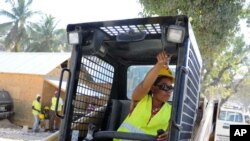January 12th marked the second anniversary of a catastrophic earthquake in Haiti, that the United Nations characterized as “the largest urban disaster in modern history.” The earthquake, which registered 7.0 on the Richter scale, was centered just 25 kilometers from Port-au-Prince, the country’s capital and largest city.
Some 3 million people were directly affected by the disaster. The government of Haiti estimates that at least 300,000 people died while about 1.5 million people were displaced to 1,300 settlement sites throughout the Port-au-Prince area.
The catastrophe galvanized the global community to immediate action. Countries sent funds and pledged more. They shipped humanitarian aid, dispatched rescue and medical teams, engineers and building specialists, and support personnel of every stripe.
At first, grief, despair and confusion reigned, but gradually, the people and government of Haiti, supported by teams of specialists from dozens of nations, began to build housing for the displaced, and to repair or build from scratch demolished hospitals, roads, ports, communications systems, a water and sanitation system, and other essential infrastructure.
Today, the enormous reconstruction effort is still underway in Haiti. As a close neighbor and a long-time friend, the United States has been one of the first to respond to the disaster and come to the aid of the Haitian people. Over the past two years, we have committed over $3.1 billion for Haiti, said Special Coordinator for Haiti Thomas Adams.
At first, emergency relief was the primary focus of the combined effort, but gradually shifted to reconstruction. So far, for example, about half of the 10 million cubic meters of rubble created by the earthquake has been removed, and about two thirds of displaced Haitians have now left the refugee camps for more permanent housing.
But now we are focused on the key challenges facing the country, including developing and expanding the Haitian National Police, creating jobs, addressing critical needs in the health and education sectors even as we continue to help rebuild Haiti’s broken infrastructure.
The U.S. government remains committed to partnering with the Government and people of Haiti, as well as the international community and will continue our work to help Haiti become a more stable and prosperous country.


















